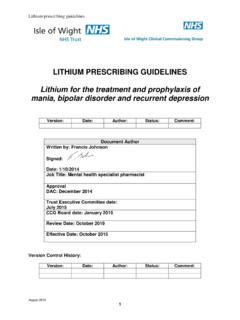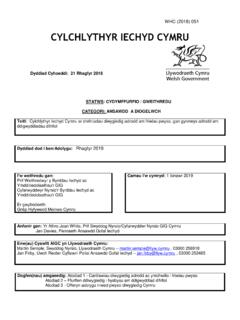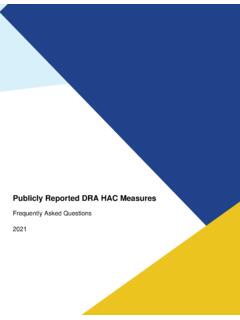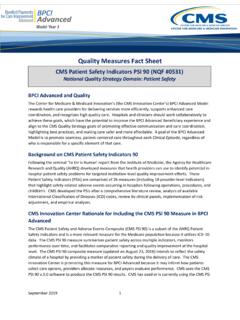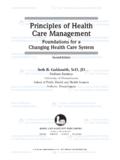Transcription of The SSKIN Bundle - Isle of Wight Primary Care Trust
1 Useful ://intranet/guidelines/ pressure %20 ulcer %20 Prevention%20and%20 Management% pressure ulcer Nutrition policy to prevent and manage malnutrition in Care programme approach and standard care policyEPUAP (2009) and SHA (2012) Guidelines for the Prevention of pressure SSKIN BundleA Reference Guide For Community Health Care Teams To be used in conjunction with the Isle of Wight NHS Trust Policy for the Prevention of pressure UlcersSKINSURFACEKEEP MOVINGINCONTINENCENUTRITION & HYDRATIONA bout the SSKIN BundleThe SSKIN Bundle is designed as a resource pack to aid in the assessment and care planning for people at risk of pressure ulcers. It is meant for use across all areas of care in the community and will be instigated where a patient is deemed at risk of pressure ulcers as indicated by use of an assessment tool or by clinical object of the SSKIN Bundle is to prompt consideration of all the health factors involved in maintaining skin integrity when planning care for a patient at risk of pressure damage.
2 The aim of the plan should be to avoid pressure injury occurring at all, and where it does, to identify problems early in order to prevent deterioration and promote MOVINGINCONTINENCENUTRITION & HYDRATIONThe following list gives a simple explanation of the meaning of some of the terms in the context they are meant within the SSKIN tendon The tendon connecting calf muscles to the disease A disease in which plaque builds up in the arteries, narrowing them and reducing blood flow through Tissue which whitens or pales with the application of pressure (and recovers its colour on release of pressure ).Concordance Agreement from the patient regarding their care plan, used in place of Thick, greasy moisturising Superficial reddening of the skin as a result of injury or A dry, dark Damage or remove part of the skin drop Extension of the foot caused by muscle wastage or paralysis, often occurs in bed bound An increase in the quantity of blood flow to a body Softening and breakdown of wet body An accumulation of fluid in the intercellular spaces of tissues; Inflammation of the bone and bone Easily felt by sense of position Lying down.
3 (Blood serum) the watery proportion of blood which separates from the clot in A pink serous fluid containing few red blood A layer or mass of dead sample A sample of surface The surface on which the patient rests mattress or of termsSkin Assessment, Monitoring and CareRisk assessment All patients will be screened using the Waterlow score at first planned visit. Waterlow reassessment will be repeated weekly or at each visit if seen 3 monthly/6 monthly/annually or if they have deterioration in their condition or on hospital discharge. Risk assessment should support not replace clinical judgement. A Waterlow score over 10 or clinical judgement that indicates the patient is at risk of pressure ulcer development indicates that a SSKIN Bundle will be implemented.
4 For patients at risk the patient and/or carer will be given an information leaflet (see end of section) and an information plan (see Patient Information Plans ).Skin assessment (see following pages) Initial skin assessment by a registered nurse will be undertaken during Waterlow risk assessment. Patients and carers will be shown how to undertake the skin tolerance test to observe for early sign of tissue damage. The registered nurse completing the care plan will tell the patient and/or carer how often they expect this to be performed. The skin tolerance test is not reliable for patients with dark skin so observe for change in tissue temperature, texture, pain and discolouration and record this on the skin assessment. Skin damage will be classified using the grading adapted from the European pressure ulcer Advisory Panel (2009).
5 The frequency of skin inspection by a registered nurse will be based on individual need according to risk status and will be recorded no more than once a day on the SSKIN Bundle . Wounds and skin conditions will be accurately recorded using wound measurements, anatomical location and photographs. The skin will be observed for damage from appliances, devices and tubing. The anatomical areas will be described accurately as per diagram below:Have you checked your patient s most vulnerable pressure points today? B Buttocks (ischial tuberosities)E Elbows/EarsS Sacrum (bottom) T Trochanters (hips)S Spine/ShouldersH HeelsO Occipital Area (back of the head) T ToesWhat to look and feel for? Redness/erythema non-blanching when finger pressure applied Pain, soreness Warmer or cooler area over bony prominence Boggy feeling Hardened area Discolouration dark red, purple, black Broken Document any changes & continue to monitor closely!
6 !!The Skin Tolerance TestNormal hyperaemic response to finger over reddened area for 15 seconds, then lift up the area blanches, it is not a stage 1 pressure ulcer . If it stays red, it is a stage 1 pressure pigmented skin does not blanch. Signs to look for in early tissue damage include purple discolouration, skin feeling too warm or cold, numbness, swelling, hardness or stages of pressure ulcers whether acquired or inherited Grades 1 4 will be reported via the organisation s incident and serious untoward incident reporting policies and procedures. A Root Cause Analysis (RCA) will be completed for all acquired Grade 3 and 4 pressure ulcers. All incident reports must include the site and stage of the ulcer , if the pressure ulcer is acquired or inherited and, if the information is available at the time, whether the reporting nurse believes the pressure ulcer to be avoidable or unavoidable.
7 All incident reports will include if the pressure ulcer is acquired or Inherited: acquired pressure damage damage that occurs whilst the patient is receiving care from Isle of Wight NHS Trust either as an inpatient or in the community Inherited pressure damage pressure ulcer present on admission when admitted into services within Isle of Wight NHS Trust All acquired avoidable and unavoidable Grade 3 and 4 pressure ulcers will be reported as requiring investigation in line with organisational policy and procedures and Isle of Wight NHS Trust Guidelines. Avoidable all pressure ulcers are deemed to be avoidable unless they meet the specific criteria listed below. Unavoidable means that the individual developed a pressure ulcer even though their condition and pressure ulcer risk had been evaluated; goals and recognised standards of care that are consistent with individual needs have been implemented; the impact of these interventions had been monitored, evaluated and recorded and the approaches had been revised.
8 All Grade 3 and 4 pressure ulcers will be referred to Tissue Viability Link Nurses. Once the link nurse has assessed, they may if they feel it is necessary to refer to the Nutrition and Tissue Viability Service for further advice. All patient s developing grade 3 4 pressure ulcers should be referred to a ulcer classification (adapted from EPUAP, 2009)Grade 1: Non-blanching erythemaIntact skin with non-blanchable redness of a localised area usually over a bony prominence. Darkly pigmented skin may not have visible blanching; its colour may differ from the surrounding area. The area may be painful, firm, soft, warmer, bluish tinge. Grade 1 may be difficult to detect in individuals with dark skin tones. May indicate an at risk 2: Partial thicknessPartial thickness loss of dermis presenting as a shallow open ulcer with a red pink wound bed, without slough.
9 May also present as an intact or open/ruptured serum-filled or sero-sanginous filled blister. Presents as a shiny or dry shallow ulcer without slough or bruising. Note that bruising may indicate deeper tissue injury. This stage should not be used to describe skin tears, tape burns, moisture lesions, maceration or 3: Full thicknessFull thickness tissue loss. Subcutaneous fat may be visible but bone, tendon or muscle are not exposed. The depth of a Grade 3 pressure ulcer varies by anatomical location. The ear, occiput and malleolus do not have fatty tissue and Grade 3 ulcers can appear shallow. In contrast, fatty areas appear deeper. Bone/tendon is not visible or directly 4: Full thicknessFull thickness tissue loss with exposed bone, tendon or muscle. Slough or eschar may be present.
10 Often includes undermining and tunnelling. The depth of a Grade 4 pressure ulcer varies by anatomical location as for Grade 3. Grade 4 ulcers can extend into muscle and/or supporting structures ( , fascia, tendon or joint capsule) making osteomyelitis likely to occur. Exposed bone/muscle is visible or directly ulcer Any pressure ulcer where depth cannot be localised area of discoloured intact skin or blood-filled blister due to damage of underlying soft tissue from pressure and/or shear. The area may be preceded by tissue that is painful, firm, mushy, boggy, warmer or cooler as compared to adjacent tissue. Deep tissue injury may be difficult to detect in individuals with dark skin tones. A thin blister may develop over a dark wound bed. The wound bed may become obscured by slough or eschar.




